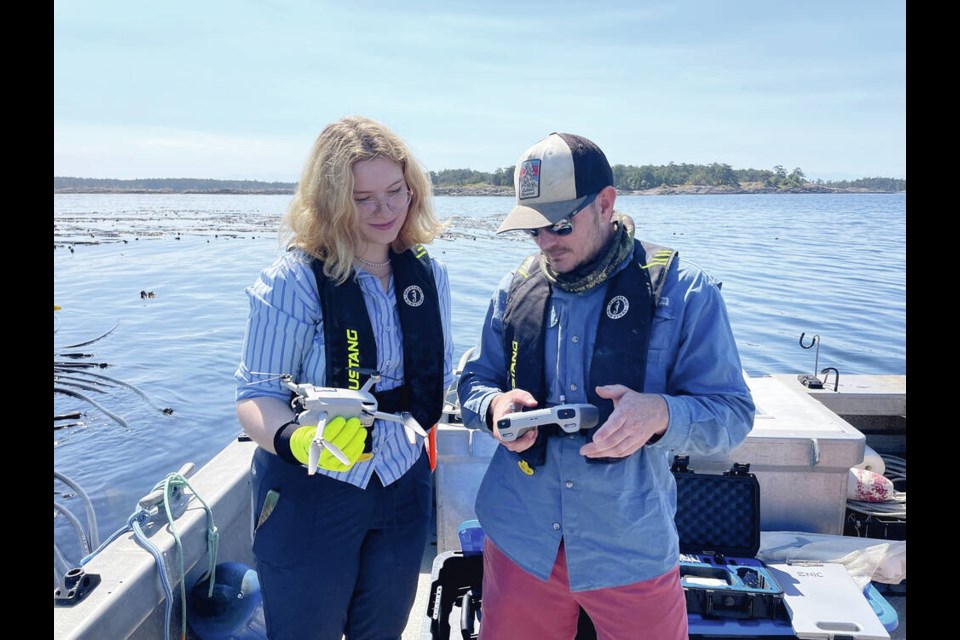Seaweed is having a moment — it’s being used in everything from food products, such as sushi and ice cream, to fertilizer, cosmetic creams and lotions.
To help coastal communities tap into the potential economic benefits, North Island College is offering seven micro-credentials — short-term courses — for up to 80 students to work in the emerging sector as part of a pilot project.
The popularity of seaweed is growing internationally, and the trend is expected to continue, said Naomi Tabata, director of the college’s Centre for Applied Research, Technology and Innovation.
“There’s a lot of different uses for seaweed and so, as the sector grows, it would be nice if we are able to support that sector to be a player in that space.”
The province is contributing $1.2 million to the pilot project over three years.
The first courses are set to start in January at the college’s Campbell River campus. In spring, programs will be available to residents of the north Island and the west coast, said Cheryl O’Connell, dean of the college’s faculty of trades and technical programs, who calls seaweeds an underutilized food source in the Western world.
Training is expected to include a combination of theoretical work and hands-on learning, with courses ranging from 36 to 65 hours. Subjects covered will include sustainable seaweed cultivation, processing and marketing.
Registration details will be available at the end of October, O’Connell said.
The program is being developed with industry and community partners.
Mark Smith, Pacific Seaweed Industry Association executive director, said the pilot project will help fill a demand for trained employees that is expected to grow “significantly” in coming decades.
Tabata, at North Island College, said B.C.’s marine waters are home to more than 200 kinds of seaweed. About half the college’s Centre for Applied Research, Technology and Innovation is already devoted to seaweed, as it works with partners in the private sector and First Nations, she said.
Centre research has looked at developing kelp pasta, using natural materials to grow kelp, mapping and measuring kelp beds, and testing the viability of using kelp in cattle feed.
The centre’s work also includes restoring kelp beds. Over many years, sea star wasting disease has helped boost sea-urchin populations, since sea stars prey on sea urchins. Urchins, in turn, feed on seaweeds, including kelp, and have decimated many kelp beds, Tabata said.
There’s interest in bringing those beds back, which would provide important habitat for many ocean species, including young salmon.
Abby Walker, who works in the centre’s lab and is studying marine biology, pilots drones to map kelp beds and uses GIS (geographic information system software) to estimate their biomass, something of interest to potential harvesters.
She grows kelp in tanks and starts out young kelp on gravel.
Using bull kelp she collects, she also makes extra-crunchy pickles that she insists are “better than regular pickles.”
The texture is consistent throughout the pickle, and they don’t get soft in the middle, she said.
The Campbell River resident found her source during a June birthday camp-out next to the ocean. “I woke up on my birthday and the whole beach was covered in kelp.”
She filled a tote with stipes — which looks similar to a long stem on a plant. Stipes connect kelp to the seabed and run up to the bulb at the top.
The kelp was transported in sea water so it didn’t get mushy.
Once home, she rinsed the kelp repeatedly with water from the hose outdoors and then washed it indoors in the kitchen sink.
Walker used stipes about 2.5 centimetres thick, which can be cut into strips or chopped into circles.
Kelp has a mild flavour similar to seawater, she said. They are high in iron and have plenty of vitamins.
That one collection yielded 43 jars of kelp pickles, Walker said. “They were a gift of nature so I am giving them away as gifts.”
She also made kelp relish and fermented the leftovers for fertilizer.
Collectors are allowed to pick up to 100 kilograms of kelp off the shore, she said, although harvesting from a boat requires a licence.
For anyone interested in making bull kelp pickles, Walker recommends a spice mixture of four parts peppercorns, two parts ground ginger, four parts caraway, one part turmeric and one part coriander, plus one sprig of dill in each jar.
She also experimented with cayenne and red pepper, and figures fennel and mustard would be good additions.
Anyone interested in the pilot program can contact [email protected].
>>> To comment on this article, write a letter to the editor: [email protected]



